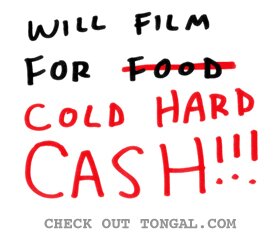Dan’s Note: Today we’re featuring a guest post from a reader named Mike Gabel. Mike started entering video contests recently and he’s already got some nice wins under his belt. I don’t want to spoil his post with a big preamble so without further ado, here’s Mike….
This is my first guest post for VCN so Dan asked me to give you a bit of my background. It all started when I and won big in the first video contest I ever entered: Buitoni’s “Girls Love Guys Who Can Cook” competition. I’ve been HOOKED ever since. I’m a one-man operation (forgive my horrible acting) and I rely heavily on my wife and five (yes, five) young daughters to be my actresses, crew and film critics. I can just imagine that some of my daughters’ earliest memories will be holding a fill light as their to shoot a video. I’m not looking for a breakout film career- I’m just happy to have a creative outlet and win a contest every now and then. You can see a bit more of my work . Overall, I love the whole video contest realm but, like many of you,have been frustrated by contests that were mismanaged or badly run. I’ve found a lot of online articles which address the marketing angle of video contest (return on investment, driving word of mouth, etc) but none really explain the basics of holding one. So I decided to explain what an average contestant wants to see in a video contest. Hopefully some future contest organizer may see this and be inspired to run a better, fairer promotion.
First, define why you want to hold a video contest. This can roughly be split into three reasons:
1. Desire a Quality Video. Your company may want to hold a video contest because you want filmmakers to generate videos that you will eventually use on your for some end use (Facebook/YouTube/website content, TV commercial, etc.). Crowdsourcing is a great alternative to traditional ad agencies since it save moneys and generate new ideas. There are a slew of great companies to host your contest (Tongal, Mofilm, Poptent to name a few) that generate extremely professional work. Poke around their websites and see what you like. Their services aren’t necessarily cheap (think tens of thousands) but they have great resources, loyal contributors and will hold your hand through the whole process. A cheaper alternative is to host your own. It can be as simple as to asking your fans to upload their entries on YouTube and then you embed their videos on your contest webpage.
2. Create Buzz. Here you hold a contest so that the contest itself gets people excited about your product or service. You want a large number of people to enter, post, share, forward, tweet, retweet and just plain talk about your contest. These contests are often linked to social media sites and more often than not have a public vote as part of the contest. If you want to outsource the work, companies like Votigo can run these types of promotions for you.
3. Merit contest. Your purpose here is to find the most talented, biggest fan, greatest idea, most deserving and any other superlative you can name. (Example: whoever can get the most people to dance to our commercial’s theme song wins a year supply of our product!) These contests tend to be less video-centric (although a good quality produced video always helps) and more people/ idea- centric.
Next you’ll want to define your contest parameters. These include:
JUDGING TYPE:
This generally falls into three categories:
Judged. A judge or judging panel selects the winner(s). This is the preferred method for most regular entrants as they want to exhibit their ideas and skills and ultimately have their work declared to be “the best.” This also give you, the sponsor, the ability to choose what video you want.
Public Vote. Public Vote contest are the equivalent to choosing the homecoming queen in high school. It’s not about the best candidate but who has the most friends. Unless you publicize your contest like crazy (think American Idol scale) you will never truly have the general public choosing the winner. The quality of the videos are usually pretty awful because the entrant’s odds of winning don’t increase by producing a quality video. So, plain and simple they’re a bad idea. I could rant for a while but the UK site Super Lucky has already done a nice job summing up why public voting contests are a bad idea.
Mixed Judging. This comes in three forms: 1. Judges narrow down the finalists and public vote decides the winners. 2. A public vote narrows down the field then judges choose the winners. 3. A public vote and judging contribute to the selection of the winner. You can guess the pluses and minuses of each of these forms. Let me point out that I put the three options in increasing order of bringing traffic to your site. So option 3 (my personal preference of mixed judging) keeps all entrants engaged and promoting their entry for the whole competition. I’ll refer back to Super Lucky blog who make some excellent points in their post, making public vote contest better.
JUDGING CRITERIA:
You need to tell your entrants what type of videos you want. For example, maybe you want a high quality video that’s sentimental, appeals to 30-somethings and showcases your product. Well tell them exactly that and which of those points are most important to you by assigning percentage values to each point. Define a clear judging criteria and stick with it. If you’re asking for humorous entries and you end up choosing emotional ones that’s not good or fair. To determine the winner the simplest (and fairest) method may be to create a ballot indicating your judging criteria (for example 35% humor, 30% adhesion to concept, 20% production quality, 15% use of unicorns) and then rate each of these 1 to 10 by as many relevant people in your organization as possible. If you just have people in your organization choose the video they like the most then there is no reason to define a judging criteria.
PRIZE AMOUNT:
The number of entries you will receive is proportional to the prize amount. Bigger prize = more entries. So what’s the magic number? Generally speaking prizes from $5K to 15K get in the ballpark of 40 -100 entries. $1,000- $2,500 normally get 20-30 entries. Less than that and your results vary. I’ve been one of only two entrants for a contest of $250. Do these numbers seem low to you? Unfortunately, this is reality and I think many sponsors realize this too late.
What should your prize be? Cash is king. But Apple products also fair well. Filmmakers LOVE video equipment, trips are good too. Just be aware of specialized prize packages as they are not always popular. Also, offering multiples prizes, like cash prizes for 1st thru 10th place, increase the contest appeal . For example, a contest offering only one $10K prize may deter entrants with its 1 in say 60 chance. But if there are 10 prizes the odds instantly go to 1 in 5.
Also keep in mind that the number of entries is also highly dependent on how well you promote your contest. There was a recent contest that offered a measly $300 prize but was promoted in conjunction with a widely popular TV show. It managed to get 30+ entries (although, none of them were all that great). So what they lacked in prize amount they had to compensate with advertising dollars.
It’s almost too obvious to use Doritos Crash the Bowl contest as a model contest but you can’t scoff at the ~3,000 entries they receive. With potentially millions in prizes and loads of promotion it is the holy grail of video contests. But that kind of success comes at a high price. Doritos spends millions of dollars promoting The Crash so those low-budget commercials actually cost the company a lot of money.
LENGTH OF CONTEST?
How long should you have you contest open for entries? My personal take is that you treat it like a wedding invite. Too little notice (less than a month) and people already have commitments and not enough time to put together all the pieces. Too far out (6 months to a year) and it loses its hype. M y recommendation is 2-3 months. Actual filming for many entrants may not start until a few weeks out from the deadline but a lot of notice gives entrants time to gets all their ducks in a row. I recommend that you have the contest end on a Sunday at midnight Pacific time- this gives people the weekend to polish their videos. Should you extend the deadline? You’re usually contemplating this because of the pitiful number of entries you’ve received (which is likely a result of low prize amount, not enough promotion, or having too niche of a concept). If you’ve done your due diligence in these areas then hold tight- a majority (up to 80% I would wager) of the entries are submitted in the last two days of the contest. Additionally, you will only add a meager number of new entries if you extend your deadline shortly before or even after (super annoying) your original deadline. So, if you extend, do it early.
OFFICIAL RULES AND LEGAL MUMBO JUMBO:
I won’t get into the nitty gritty about how to write your official rules but my recommendations are to look at other contests’ rules and modify theirs according to your needs. If you have a legal department make sure they sign off on them. Another downside of public vote contests in that you need to cover more of what is or is not allowed, likevote farming.
Last step, promote your contest:
Step one, make a contest webpage and make it look polished and official- if your website looks sketchy I’m not entering and I’m guessing others aren’t either. Step two: send the info to OnlineVideoContest.com so they can post it. Final step: do you social media magic, reach out through email, make a flyer if you have a retail outlet, tell your friends and neighbors to enter (unless it’s prohibited in your rules) and have your coworkers tell their friends and neighbors, reach out to filmmakers- get creative.
FINAL WORDS OF WISDOM:
Have a contact email: A dedicated email or forum is critical because questions will arise. If entrants have no way to contact you they will feel isolated and frustrated and they might produce videos that are not what you are looking for.
Make the video time limit reasonable: This is more for your sanity because you’ll be pulling out your hair if you have to review a slew of 5 minute videos. Only put longer time limits (say 3 min plus) if it is an absolute necessity. The challenge that you pose to the entrants is to tell a story in a brief period. 1-2 min is my personal sweet spot.
Keep the contest page updated: If something changes (rules, deadline extension, general update) change it on the contest page and make it apparent. Don’t just posts it on Facebook because entrants are not always looking there.
Make good on your word: So your contest was a flop and you only received a handful of entries. Now you’re contemplating whether to pay out the prizes. Just do it! Be as loyal to the entrants as they were loyal to your contest.
Announce the winner: Some contests never actually post the video that won their contest. Think of how crummy it would be if they cut out the second half of the Miss America Pageant or the season finale of American Idol. It’s always nice to know who won so even if the winning video isn’t great (if it’s not, that probably means you let voters pick the winner) you need to post it.
-




















